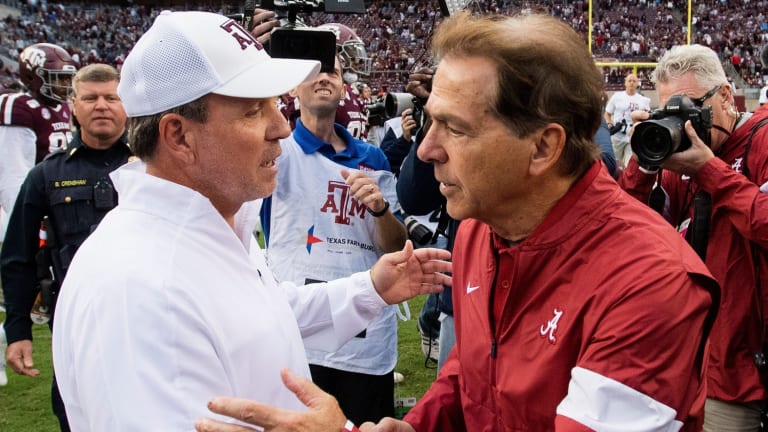
Mr. CFB: Is Jimbo Fisher-Nick Saban Feud Over For Now? Stay Tuned

Destin, Fla.—Catching up on a few things as the 2022 SEC Spring Meetings draw to a close:
Needless to say, the most-attended media session with a coach this week was Wednesday’s visit with Texas A&M’s Jimbo Fisher. Remember that Fisher and Alabama’s Nick Saban had a very-public dustup a couple of weeks ago when Fisher used words like “narcissistic” and “despicable” to describe Saban’s statement that Fisher “had bought” all the members of Texas AM’s No. 1 ranked recruiting class.
On Tuesday Saban met with the media at the Sandestin Hilton and was quickly confronted with those words by a reporter from an Aggies’ news site.
Saban’s position was that while he did use those words “I never said that anybody did anything wrong.” And he stuck with that.
So on Wednesday the media wanted to see if Fisher would again come out smoking in response to Saban’s words.
He did not.
Fisher, ironically, was the chairman of the coach’s group and had just conducted their meeting when he talked to the media.
“I got them out of there in record time,” he said when I met with him briefly before the interview session.
Fisher walked into that room armed with his talking points—or point—when asked about his conflict with Saban, which dominated the headlines going into these meetings.
“We’re moving on,” he said every time he was asked about Saban. Fisher did not stray from that talking point the rest of the session.
So is it REALLY over?
This part of it appears to be. What you had were two very competitive guys from West Virginia each trying to get a leg up on the other.
But the competitive stresses (NIL, transfer portal, winning in the SEC etc.) are not going away. And if I were a betting man I would bet that they will rear their ugly heads again—if not these two coaches then some other coaches.
Remember: The two teams will meet on Oct. 8 in Tuscaloosa and first place in the SEC West could be on the line.
SCHEDULE MODELS: The football coaches were presented two scheduling models for the future. One model keeps the number of conference games at eight. The other increases the number of conference games to nine.
In the eight-game, or 1-7 model, schools would have one permanent rivalry game each year (think Alabama vs. Auburn, Georgia vs. Florida). The other seven games would rotate on and off the schedule on a yearly basis,
The nine-game, or 3-6 model, would give each team three permanent opponents (think Georgia vs. Florida, Auburn, and South Carolina). Six other teams would fill out the schedule. The next year those six rotate off and six new teams rotate on.
That means that in just two years each team would have played every other team in the conference. In four years every team would have played every other team in the conference both home and away.
SEC Commissioner Greg Sankey has made it clear this week that teams need to rotate through the conference more quickly. So it has been pretty clear this week that divisional play, which has been a part of the SEC since it first expanded in 1992, is going away.
This is unscientific, but based on the people I’ve talked to this week, I would say that the 3-6 model is gaining some traction.
“We have heard from our season ticket holders that we need to keep the schedules fresh,” said Scott Strickland, the athletics director at Florida.
Now, not every school agrees. Schools like Alabama, Georgia, and Florida would favor a nine-game schedule because it strengthens their overall schedule when it comes to qualifying for the playoff. Alabama’s Nick Saban and Georgia’s Kirby Smart are on record as supporting nine conference games
“I want to do what’s best for the conference,” said Smart.
Commissioner Sankey has said this week that the conference may or may not vote on this issue on Friday, when he meets with the SEC presidents. Right now the SEC doesn’t know if Texas and Oklahoma will join before the 2025 season, which is the current time line, And that’s certainly a factor.
The conference also doesn’t know if the College Football Playoff will expand from its current four teams into something larger in the coming years,
Sankey put forth a proposal for a 12-tean CFP earlier this year but it was shot down by a vote of 8-3. The current CFP contract goes through the 2025 season
Sankey said Tuesday he would be willing to discuss an eight-team model if there were no automatic qualifiers. In other words, all Power Five conference champs would get a bid regardless of their record. That would create a situation where a team ranked No. 20 could get into the playoff over a team ranked in the top 10. A 12-team model makes it less likely a deserving team that did not win its conference gets left out.
And there has been some reporting this week that if the SEC cannot get the cooperation it needs from the other Power Five conferences, it could break away and hold its own tournament championship.
Is it likely to happen?
No.
Is Sankey shooting the idea down when asked about it?
No.
That’s because everything is on the table up until the point that the decision is made. In these negotiations he wants to keep all options—no matter how far outside the box—open for business.
“We are not taking anything off the table,” said Sankey, who will meet with the media on Friday afternoon to announce what decisions the conference has made.
This could be a good one.